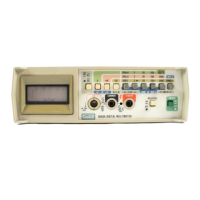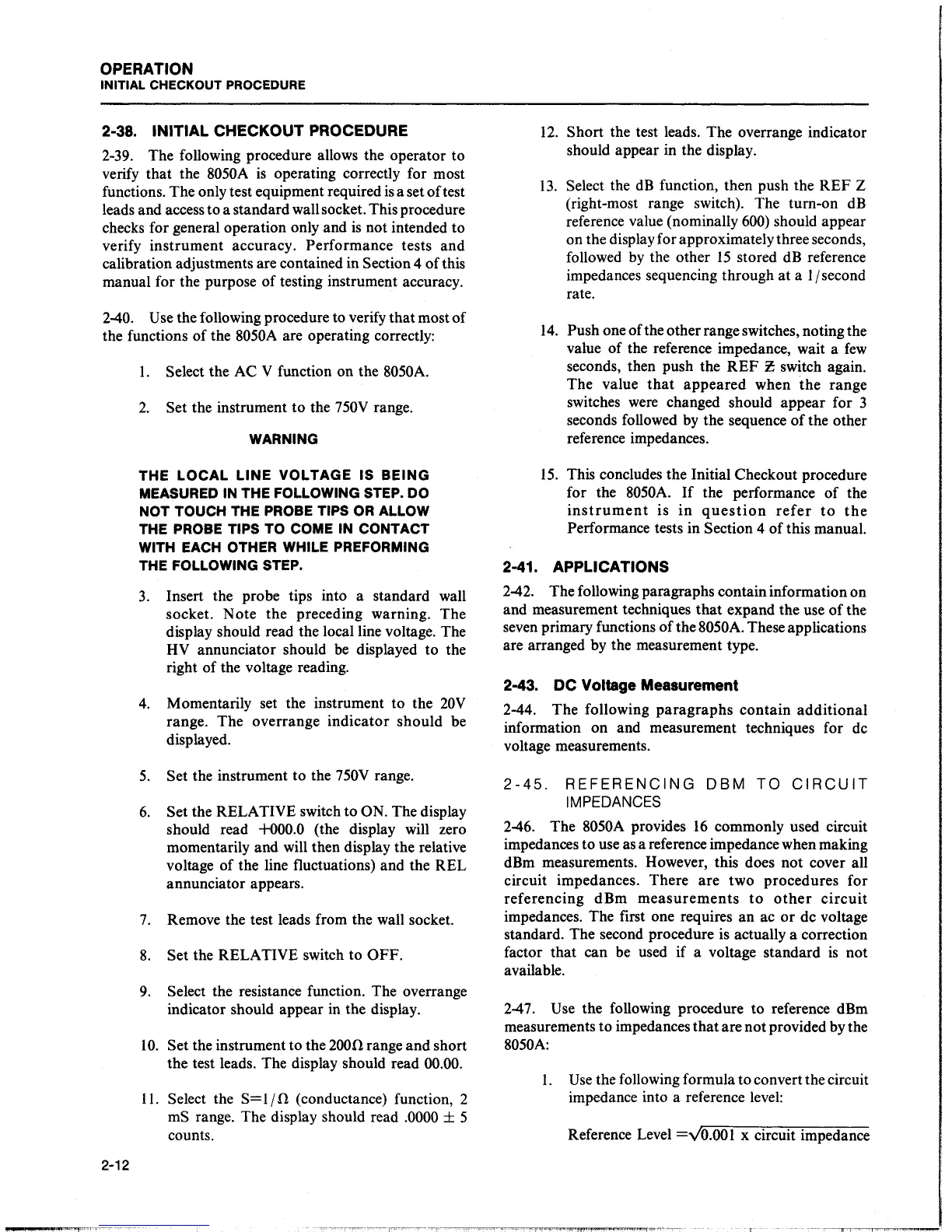OPERATION
INITIAL CHECKOUT PROCEDURE
2-38. INITIAL CHECKOUT PROCEDURE
2-39.
The following procedure allows the operator to
verify that the 8050A
is
operating correctly for most
functions. The only test equipment required
is
a set
of
test
leads and access to a standard wall socket. This procedure
checks for general operation only and
is
not intended to
verify instrument accuracy. Performance tests and
calibration adjustments are contained in Section 4
of
this
manual for the purpose
of
testing instrument accuracy.
2-40. Use the following procedure to verify that most
of
the functions
of
the 8050A are operating correctly:
2-12
I.
Select the AC V function on the 8050A.
2.
Set the instrument to the
750V
range.
WARNING
THE
LOCAL
LINE
VOLTAGE IS BEING
MEASURED IN THE FOLLOWING STEP. DO
NOT TOUCH THE
PROBE
TIPS
OR
ALLOW
THE PROBE TIPS TO COME IN CONTACT
WITH EACH OTHER WHILE PREFORMING
THE FOLLOWING STEP.
3.
Insert the probe tips into a standard wall
socket. Note the preceding warning. The
display should read the local line voltage. The
HV annunciator should
be
displayed to the
right
of
the voltage reading.
4.
Momentarily set the instrument to the
20V
range. The overrange indicator should be
displayed.
5.
Set the instrument to the
750V
range.
6.
Set the RELATIVE switch to ON. The display
should read
+ooo.o
(the display will zero
momentarily and will then display the relative
voltage
of
the line fluctuations) and the REL
annunciator appears.
7.
Remove the test leads from the wall socket.
8.
Set the RELATIVE switch
to
OFF.
9.
Select the resistance function. The overrange
indicator should appear in the display.
l
0.
Set the instrument to the
2000
range
and
short
the test leads. The display should read 00.00.
11.
Select the
S=l/!l
(conductance) function, 2
mS range. The display should read .0000
± 5
counts.
-
--
-----~-------
r·.,,-,_,
__
_,
___
~,
12.
Short the test leads. The overrange indicator
should appear in the display.
13.
Select the
dB
function, then push the
REF
Z
(right-most range switch). The turn-on
dB
reference value (nominally 600) should appear
on the display for approximately three seconds,
followed by the other
15
stored dB reference
impedances sequencing through at a l /second
rate.
14.
Push one
of
the other range switches, noting the
value of the reference impedance, wait a
few
seconds, then push the
REF
l;
switch again.
The value
that
appeared when the range
switches
were
changed should appear for 3
seconds followed
by
the sequence
of
the other
reference impedances.
15.
This concludes the Initial Checkout procedure
for the 8050A.
If
the performance
of
the
instrument
is
in
question
refer
to
the
Performance tests in Section 4
of
this manual.
2-41. APPLICATIONS
2-42. The following paragraphs contain information on
and measurement techniques
that
expand the use
of
the
seven primary functions
of
the 8050A. These applications
are arranged by the measurement type.
2-43. DC Voltage Measurement
2-44. The following
paragraphs
contain
additional
information on and measurement techniques for de
voltage measurements.
2-45.
REFERENCING
DBM
TO
CIRCUIT
IMPEDANCES
2-46. The 8050A provides
16
commonly used circuit
impedances to use as a reference impedance when making
dBm measurements. However, this does not cover all
circuit impedances. There are two procedures for
referencing
dBm
measurements
to
other
circuit
impedances. The first one requires an ac
or
de voltage
standard. The second procedure is actually a correction
factor that can be used if a voltage standard
is
not
available.
2-47. Use the following procedure to reference dBm
measurements to impedances that are not provided by the
8050A:
I.
Use
the following formula to convert the circuit
impedance into a reference level:
Reference Level =v'0.00 I x circuit impedance

